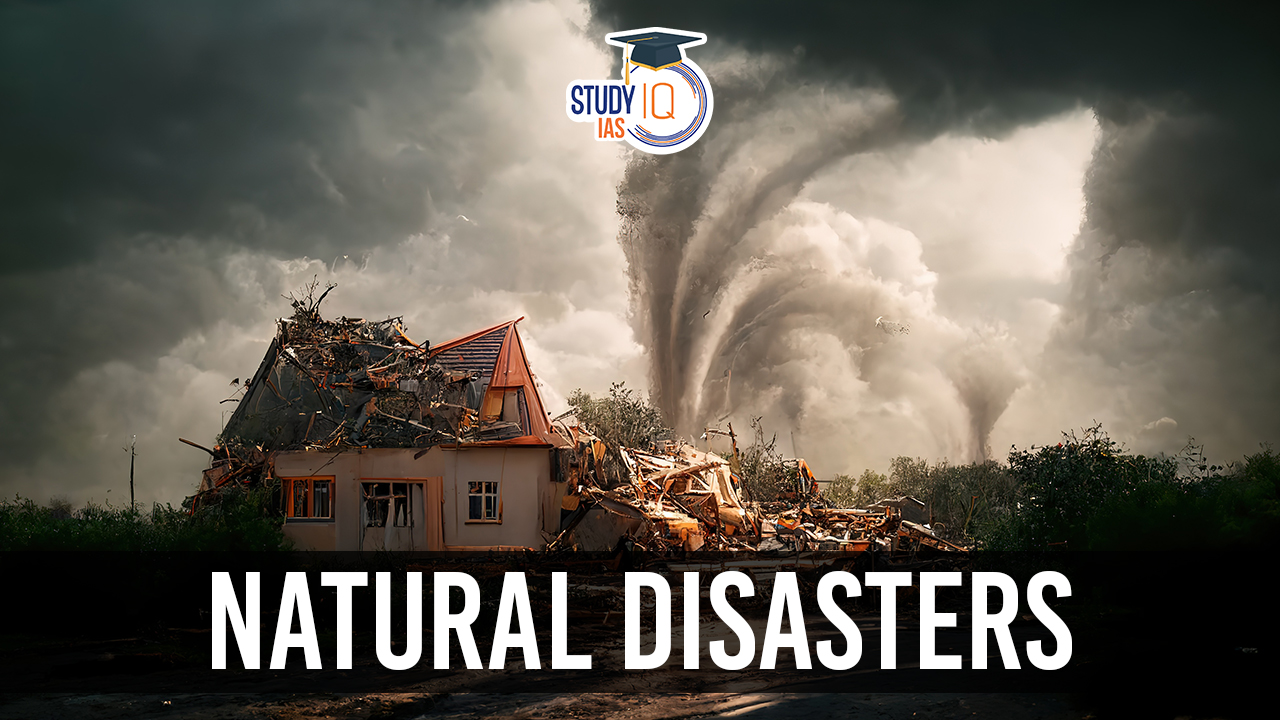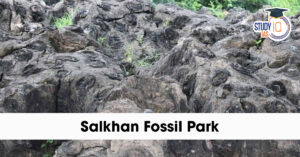Table of Contents
Natural disasters are catastrophic events that stem from various natural phenomena on Earth, with a history spanning the planet’s 4.54 billion years. These events, ranging from floods and hurricanes to tsunamis and earthquakes, have had profound effects on the environment and the diverse species that inhabit the Earth.
We’re now on WhatsApp. Click to Join
What Natural Disasters?
A natural disaster is a major event caused by Earth’s natural processes, resulting in widespread destruction to the environment and loss of life. It typically follows a natural hazard, such as living in an area with active fault lines, as exemplified by the Gujarat Earthquake in 2001.
It’s noteworthy that some natural hazards can be influenced by human activities. For instance, deforestation, mining, and agriculture can trigger landslides, emphasizing the interconnectedness between natural processes and human actions.
Types of Natural Disasters
Natural disasters can be categorized into geological, hydrological, meteorological, space disasters, and other types.
| Category | Examples | Description |
| Geological Disasters | Avalanche, Landslides, Earthquakes, Sinkholes, Volcanic Eruption | Catastrophic events related to changes in the Earth’s surface, including movements of the Earth’s crust and volcanic activity. |
| Hydrological Disasters | Flood, Tsunami, Limnic Eruption | Events involving water, such as overflowing, large waves, and sudden releases of dissolved gases from deep lakes. |
| Meteorological Disasters | Cyclonic Storm, Blizzard, Cold Waves, Heat Waves, Drought, Hailstorms, Tornadoes | Weather-related events including storms, extreme temperatures, and atmospheric disturbances. |
| Space Disasters | Solar Flares, Gamma-Ray Bursts, Impact Events | Events originating beyond Earth, such as intense bursts of solar radiation, energetic explosions, and celestial body collisions. |
Geological Disasters
Avalanche
An avalanche refers to a sudden and rapid descent of snow, ice, and debris down the slopes of a mountain or a steep incline. This natural occurrence is often triggered by factors such as snow accumulation, temperature changes, or disturbances, leading to a cascading flow of snow, ice, and accompanying debris down the mountainous terrain. Avalanches can pose significant threats to both human settlements and natural landscapes, impacting the ecosystem and potentially causing harm to individuals caught in their path.
Landslides
Landslides are geological events characterized by the movement of rock, soil, and debris down a slope. This movement can be triggered by various factors, including heavy rainfall, earthquakes, volcanic activity, or human-induced disturbances such as deforestation. Landslides can result in the displacement of large volumes of earth material, leading to the destruction of infrastructure, alteration of landscapes, and posing risks to communities situated in landslide-prone areas.
Earthquakes
Earthquakes are seismic events caused by the shifting of tectonic plates beneath the Earth’s surface. This movement generates intense shaking of the ground, resulting in seismic waves that propagate through the Earth. Earthquakes vary in magnitude, with higher magnitudes indicating more significant seismic energy release. These natural phenomena can have widespread and devastating impacts on communities, causing structural damage to buildings, triggering landslides, and sometimes leading to tsunamis in coastal regions.
Sinkholes
Sinkholes are abrupt collapses in the Earth’s surface, occurring due to underground erosion of soluble bedrock, such as limestone or gypsum. When water gradually dissolves these rocks, underground voids or cavities can form. If the overlying material can no longer support its own weight, it collapses into the void, creating a sinkhole. These sudden depressions in the ground can appear without warning, posing risks to infrastructure and landscapes. Human activities, such as excessive groundwater pumping, can exacerbate sinkhole formation.
Volcanic Eruption
A volcanic eruption is the forceful release of magma, ash, and gases from a volcano. This occurs when pressure beneath the Earth’s crust causes molten rock to erupt through the surface. Volcanic eruptions can take various forms, including explosive eruptions with ash clouds and pyroclastic flows or effusive eruptions with the slow release of lava. The consequences of volcanic activity can be severe, impacting the surrounding environment, climate, and posing hazards to nearby communities through ashfall, lava flows, and even secondary events like lahars (mudflows) or volcanic tsunamis.
Hydrological Disasters
Flood
A flood is a natural disaster characterized by the overflow of water onto areas that are typically dry. This can occur due to various reasons, including heavy rainfall, storm surges, rapid melting of snow or ice, or the sudden release of water from natural reservoirs such as dams. Floods can result in extensive damage to infrastructure, displacement of populations, loss of crops, and contamination of water sources. The severity of floods can range from localized flash floods to large-scale riverine floods, each posing unique challenges for preparedness, response, and recovery efforts.
Tsunami
A tsunami is a series of ocean waves with extremely long wavelengths and high energy, typically caused by underwater disturbances such as earthquakes, volcanic eruptions, or underwater landslides. When these disturbances displace a large volume of water, it sets off a chain reaction that results in the formation of powerful and often destructive tsunami waves. Tsunamis can travel across entire ocean basins, making them capable of impacting coastlines far from the source. The immense energy carried by these waves can lead to widespread inundation of coastal areas, causing significant loss of life, destruction of infrastructure, and long-term economic and environmental consequences.
Limnic Eruption
A limnic eruption, also known as a lake overturn, is a rare and potentially deadly natural event that involves the sudden release of dissolved gases from the depths of a lake. This phenomenon typically occurs in deep, stratified lakes where layers of water have different temperatures and chemical compositions. If triggered by a geological event or other factors, such as volcanic activity or an earthquake, the deep layers of water may undergo a rapid and violent mixing process. This mixing causes the release of large amounts of dissolved gases, such as carbon dioxide, into the lake and its surroundings. The discharged gases can be lethal to both aquatic life and nearby human populations, as they can displace the oxygen necessary for survival. While relatively infrequent, limnic eruptions have the potential for catastrophic consequences, emphasizing the importance of monitoring and understanding the conditions of deep lakes prone to such events.
Meteorological Disasters
Cyclonic Storm
A cyclonic storm is a meteorological phenomenon characterized by a rotating low-pressure weather system. These storms are known by different names in various regions, such as hurricanes in the Atlantic and northeastern Pacific, typhoons in the northwestern Pacific, and cyclones in the South Pacific and Indian Ocean. Cyclonic storms derive their energy from warm ocean waters, and their distinctive circular motion is driven by the Earth’s rotation. These storms can unleash powerful winds, heavy rainfall, and storm surges, causing widespread damage to coastal areas. The intensity of cyclonic storms is categorized on scales like the Saffir-Simpson Hurricane Wind Scale, with higher categories indicating stronger and more destructive storms.
Blizzard
A blizzard is an intense and severe snowstorm characterized by strong winds, low temperatures, and reduced visibility due to blowing snow. Blizzards typically occur in regions with cold climates and sufficient moisture content in the air. The combination of heavy snowfall and strong winds creates whiteout conditions, making travel extremely hazardous. The impact of blizzards extends beyond transportation disruptions to include power outages, damage to infrastructure, and threats to human safety. Effective preparation and response strategies are crucial to mitigating the risks associated with blizzards.
Cold Waves, Heat Waves, Drought
Extreme temperature events encompass cold waves, heat waves, and droughts, each presenting unique challenges to ecosystems and human societies. Cold waves involve an extended period of unusually cold temperatures, potentially leading to freezing conditions, frostbite, and stress on heating systems. Heat waves, on the other hand, bring prolonged periods of excessively high temperatures, causing heat-related illnesses, stressing power grids, and posing risks to vulnerable populations. Droughts involve prolonged periods of abnormally low precipitation, leading to water scarcity, crop failures, and ecological imbalances. These extreme temperature events underscore the importance of adaptive measures, water conservation, and public health interventions to mitigate their impacts.
Hailstorms, Tornadoes
Hailstorms and tornadoes are destructive meteorological phenomena associated with severe thunderstorms. Hailstorms involve the formation of large hailstones due to updrafts in thunderstorm clouds. These hailstones can cause damage to crops, vehicles, and structures. Tornadoes are violent and rotating columns of air extending from thunderstorms to the ground. They can have devastating impacts, destroying buildings, uprooting trees, and posing severe threats to life and property. Early warning systems, storm shelters, and community preparedness are essential for minimizing the risks associated with hailstorms and tornadoes.
Space Disasters
Solar Flares
Solar flares are intense bursts of energy and radiation emanating from the Sun’s surface. They occur in the Sun’s outer atmosphere, or corona, and are triggered by the complex interplay of magnetic fields. During a solar flare, there is a rapid release of energy in various forms, including X-rays, ultraviolet light, and charged particles. The sudden increase in solar radiation can impact space weather and cause disturbances in the Earth’s atmosphere. While solar flares do not pose a direct threat to human health, they can affect communication systems, navigation equipment, and power grids. Monitoring solar activity is crucial for space agencies and utilities to minimize potential disruptions caused by these energetic outbursts.
Gamma-Ray Bursts
Gamma-ray bursts (GRBs) are highly energetic explosions that release an extraordinary amount of gamma-ray radiation, the most energetic form of electromagnetic radiation. These bursts can last from milliseconds to several minutes and are observed in distant galaxies. The exact mechanisms that trigger gamma-ray bursts are still under investigation, but they are often associated with cataclysmic events such as the collapse of massive stars or the merging of binary neutron stars. While GRBs are not a direct threat to Earth due to their distance, they provide valuable insights into the processes shaping the universe. The energy released in gamma-ray bursts is so immense that, if occurring nearby, it could have severe consequences for life on Earth, making their study important for understanding the broader cosmic landscape.
Impact Events
Impact events refer to collisions between celestial bodies, such as asteroids or comets, and planets or moons. One of the most well-known impact events in Earth’s history is the Chicxulub impact, which occurred approximately 66 million years ago. This impact, involving a large asteroid, is widely believed to be a major contributing factor to the mass extinction event that wiped out the dinosaurs. Impact events can have catastrophic consequences, causing widespread fires, tsunamis, and altering the Earth’s climate. While large impacts are rare on human timescales, studying and monitoring near-Earth objects is crucial for understanding potential threats and developing strategies for planetary defense. Advances in space observation technology allow scientists to identify and track these celestial bodies, providing early warning and the potential for mitigating measures if a significant impact threat is identified.
Natural Disasters Examples
| Type of Natural Disaster | Disaster | Date | Affected Areas | Event |
| Geological Disasters | Avalanche | 31 May 1970 | Huascaran-Ancash, Peru | An earthquake triggered an avalanche in Peru, resulting in nearly 20,000 casualties. |
| Landslides | 18 August 1998 | Malpa, Uttarakhand | An entire village was wiped away in the Pithoragarh district of Uttarakhand. | |
| Earthquakes | 26 January 2001 | Gujarat | An earthquake with a magnitude of 7.9 on the Richter scale struck Gujarat, resulting in over 100,000 casualties. | |
| Sinkholes | February 2007 | Guatemala City, Central America | A sinkhole over 100 meters deep formed suddenly, resulting in the death of five people and the evacuation of thousands. | |
| Volcanic Eruption | 79 AD | Italy | Mount Vesuvius erupted, releasing 100,000 times the thermal energy of the Hiroshima-Nagasaki bombings, causing an estimated 2,000 deaths. | |
| Hydrological Disasters | Flood | 1931 | Republic of China | Widespread floods devastated China, marking one of the deadliest floods in history with an estimated death toll between 3.7 million to 4 million. |
| Tsunami | 11 March 2011 | Pacific Coast of Japan | A 9.0 magnitude earthquake caused a 33 feet high tsunami resulting in over 18,500 deaths and a nuclear meltdown at the Fukushima Nuclear Power Plant. | |
| Limnic Eruption | 21 August 1986 | Lake Nyos, Cameroon | The Lake Nyos limnic eruption killed 1746 people and 3500 cattle, representing a rare and deadly natural disaster. | |
| Meteorological Disasters | Cyclonic Storm | 2020 | India | Cyclone Amphan caused widespread damage in Eastern India, while Cyclone Nisarga wreaked havoc on the West Coast of India. |
| Blizzard | 1972 | Iran | A blizzard in 1972 dropped nearly 26 feet of snow, covering 200 villages in Iran and causing the death of 4,000 individuals. | |
| Cold Waves | 2020 | Baghdad | Baghdad experienced the very first snowfall since the 1910s. | |
| Drought | 2015-18 | Cape Town, South Africa | Cape Town faced a major water crisis between 2017 and 2018, impacting public health and the nation’s economy. | |
| Tornadoes | April 26, 1989 | Daulatpur–Saturia, Bangladesh | The Daulatpur-Saturia tornado was the deadliest tornado in recorded history, causing approximately 1,300 deaths and injuring an estimated 12,000 people. | |
| Space Disasters | Impact Events | ~66 million years | Entire Earth | The Chicxulub impactor struck Earth roughly 66 million years ago, causing the extinction of 75% of all plant and animal species. |
| Other Types of Disasters | Forest Fires | 2019-2020 | Australia | The 2019-20 Australian Bushfires resulted in 34 deaths, destruction of 5,900 buildings, and an estimated 46 million acres were burnt. |
Natural Disasters in India
- Geographical Vulnerabilities: India’s diverse topography, ranging from the Himalayas to coastal regions, exposes it to various natural disasters.
- Earthquakes: The Himalayan belt and other seismic zones make India prone to earthquakes, with historical instances causing significant damage.
- Cyclones: Coastal regions, especially in the Bay of Bengal and the Arabian Sea, face the recurring threat of cyclones, impacting lives and infrastructure.
- Floods: Monsoon rains lead to floods in many states, causing displacement, agricultural losses, and damage to property.
- Landslides: Hilly terrains, particularly during the monsoon, are susceptible to landslides, affecting communities and transportation.
- Droughts, Heatwaves, and Cold Waves: Different parts of India experience extremes in temperature, leading to droughts, heatwaves, and cold waves, impacting agriculture and human health.
- Urban Challenges: Urban areas grapple with issues like pollution, affecting public health and adding to the disaster management challenges.
- Ongoing Mitigation Efforts: Despite efforts to enhance disaster preparedness and response, India continues to require resilient infrastructure and comprehensive mitigation strategies.
Natural Disasters UPSC
Natural disasters, stemming from Earth’s processes over 4.54 billion years, encompass floods, hurricanes, tsunamis, and earthquakes, profoundly impacting the environment and life. Triggered by natural hazards like active fault lines, some are influenced by human activities. Categorized into geological, hydrological, meteorological, and space disasters, examples include avalanches, floods, cyclones, solar flares, and impact events. These events, such as the 2001 Gujarat Earthquake or the 2011 Japanese tsunami, demonstrate the interconnectedness between Earth’s processes and human existence.


 Species Added to India's Flora and Fauna...
Species Added to India's Flora and Fauna...
 Largest Desert in the World, Check Name,...
Largest Desert in the World, Check Name,...
 Salkhan Fossil Park Joins UNESCO’s Ten...
Salkhan Fossil Park Joins UNESCO’s Ten...





















